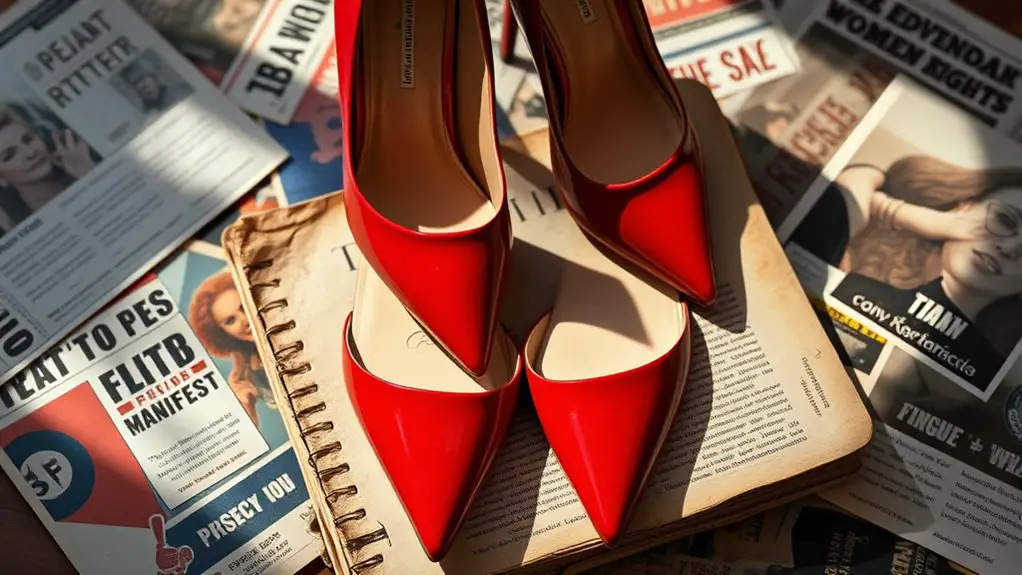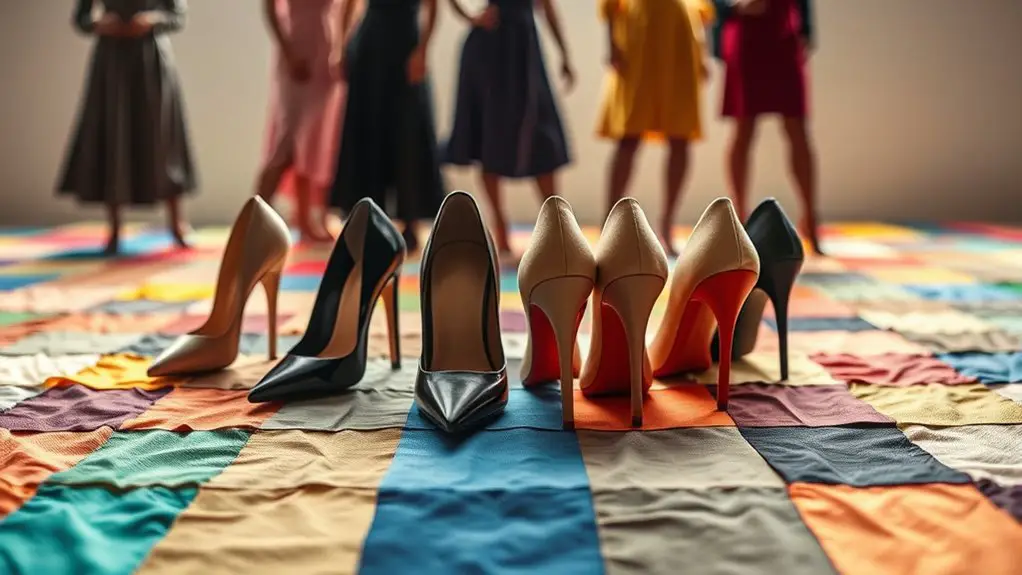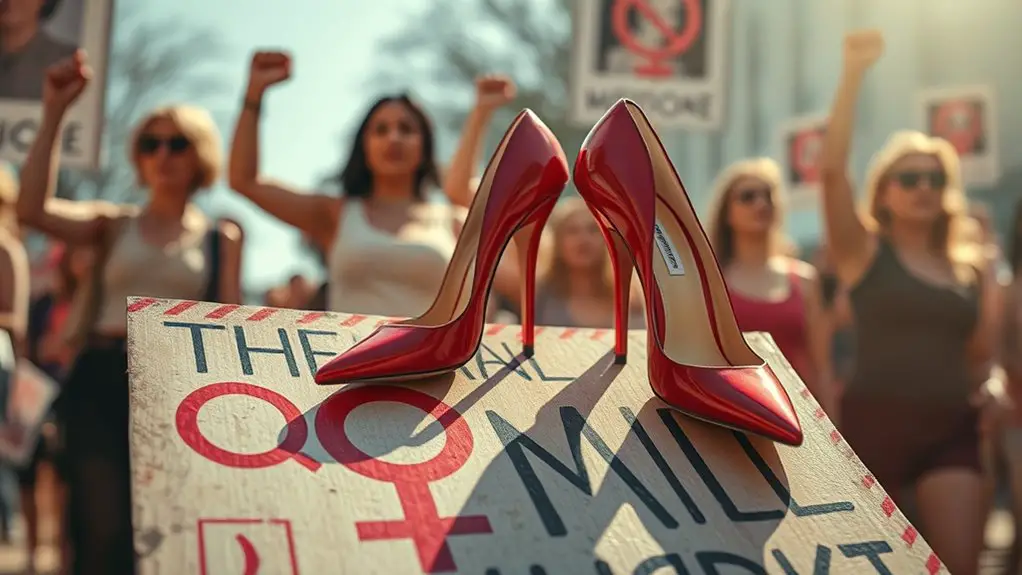Heels are represented in feminist movements as complex symbols of empowerment and constraint. They can boost confidence and assert presence, yet often reinforce societal expectations that prioritize aesthetics over comfort. This duality sparks debate about objectification and gender norms, particularly in professional settings where heels are expected. Their intersectionality reveals nuances related to race, class, and disability, complicating the narrative around femininity. Exploring these dynamics further, you’ll uncover more about the evolving relationship between heels and feminist thought.
The Historical Context of Heels in Feminism

Although heels have often been dismissed as mere symbols of patriarchy, their place in feminist movements is far more complex and layered. You might find it intriguing that, historically, heels were first worn by men in the 16th century, primarily signifying status and power. Over time, their evolution into women’s fashion invites a rich feminist critique, questioning why something so loaded with social implications became a staple in women’s wardrobes. The historical significance of heels illustrates how women’s fashion has often been co-opted for both empowerment and oppression. Feminists argue that embracing or rejecting heels can serve as a political statement—highlighting the double-edged sword of femininity. By examining this duality, you can better appreciate how heels are not just fashion items but also artifacts of cultural struggle, reflecting evolving attitudes toward gender and power.
Heels as Symbols of Empowerment
Empowerment often comes wrapped in layers of complexity, especially when it comes to high heels. For many, these shoes aren’t just style choices; they serve as powerful symbols within empowerment narratives. By donning heels, you might feel an immediate boost in confidence, as if you’re stepping into a version of yourself that demands attention and respect. This transformation is often celebrated in feminist discourse, where heels are seen as a means of reclaiming femininity and agency, rather than a tool of subjugation.
However, this narrative isn’t without contention. The empowerment derived from heels can be deeply personal, resonating with those who embrace them as an assertion of independence. Yet, it simultaneously raises questions about societal expectations and the very nature of empowerment. Ultimately, heels can embody both liberation and constraint, reflecting the multifaceted journey of women traversing their identities in a complex world.
The Objectification Debate

Heels, while often celebrated as symbols of empowerment, also stir a complex debate around objectification. You might find yourself caught in the empowerment paradox: can you truly feel powerful in something that others deem objectifying? The objectification critique challenges you to ponder whether heels reinforce traditional gender roles or empower women to embrace their femininity. As you navigate this terrain, think about how societal expectations shape your choices. Are you wearing heels for yourself, or to fit an external mold?
The allure of heels often lies in their ability to enhance stature and confidence, yet they also invite scrutiny and objectification. This duality forces you to confront uncomfortable questions about autonomy and the ways your appearance is perceived. Ultimately, it’s vital to acknowledge this tension, as it reflects broader societal issues surrounding women’s rights and self-expression in a world that still grapples with outdated norms.
High Heels and the Workplace
In many professional settings, the expectation to wear high heels can create a subtle yet significant pressure on women. This societal norm often intertwines with office attire, suggesting that higher heels contribute to a polished professional image. But have you ever considered how this expectation might undermine your comfort and even productivity?
While heels may enhance the perceived authority or femininity of your appearance, they also reinforce outdated gender norms that prioritize aesthetics over functionality. The insistence on wearing them can often lead to discomfort and distraction, ultimately questioning the very foundation of workplace equality.
As you navigate your career, reflect on how this pressure affects not just your personal comfort, but also the broader implications for women in the workforce. High heels shouldn’t dictate your professional worth, and challenging this expectation might be an essential step toward redefining office attire and fostering a more inclusive work environment.
Intersectionality and Heels

While many might perceive high heels as a mere fashion choice, their implications run deeper, intersecting with issues of race, class, and disability. The cultural significance of heels can’t be overlooked; they’re often a marker of femininity and status, yet they can also reinforce restrictive social expectations. For those with intersectional identities, the choice to wear heels may reflect a struggle between personal autonomy and societal pressure. A feminist critique of heels examines how body politics shape our understanding of beauty and power. Women from marginalized backgrounds may experience different pressures related to fashion autonomy, as their aesthetic agency is often dictated by external norms. Ultimately, the conversation around heels reveals the complexities of choice within a framework that frequently prioritizes certain identities over others, challenging us to rethink how we navigate these layered meanings in a diverse society.
Cultural Representations of Heels
When you consider the cultural representations of heels, it’s impossible to ignore their complex history, from symbols of power to tools of oppression. These narratives shape contemporary fashion perspectives, often reflecting deeper feminist dialogues about agency and identity. Are heels a celebration of femininity, or do they perpetuate societal constraints?
Historical Context of Heels
Although heels have often been viewed through a lens of objectification and femininity, their historical context reveals a complex tapestry of cultural representations that challenge simplistic interpretations. Initially, heels were a symbol of social status, worn by aristocrats to elevate themselves literally and figuratively. As fashion evolved, they morphed from a utilitarian accessory for horse riders in the 16th century to a staple of women’s fashion, embodying both power and allure. This evolution reflects changing societal norms, where heels became a battleground for debates on gender and empowerment. By examining these shifts, you can understand how heels have been appropriated and contested, revealing deeper narratives about identity and societal expectations that go beyond mere aesthetics.
Symbolism in Feminism
The complex history of heels sets the stage for their multifaceted symbolism within feminist movements. Heels can serve as both a canvas for feminist expression and a battleground for shoe politics, reflecting diverse perspectives on gender and power.
- Heels symbolize empowerment, allowing women to reclaim their bodies and assert confidence.
- Conversely, they can represent societal pressure, perpetuating unrealistic beauty standards.
- Heels also serve as a critique of traditional femininity, challenging norms while embracing personal choice.
- Finally, they become a form of resistance, as women use them to subvert expectations in various contexts.
Ultimately, heels encapsulate the tensions within feminism, showcasing how something seemingly trivial can ignite discussions on identity, autonomy, and societal expectations.
Contemporary Fashion Perspectives
While heels have long been a staple of fashion, their significance in contemporary culture extends far beyond mere aesthetics, intertwining with discussions of power dynamics and personal identity. You’ll notice how sustainable fashion advocates embrace heels, pushing for ethical production and challenging cultural appropriation. Fashion activism promotes body positivity, empowering individuals to express their unique gender identities through style diversity and inclusive sizing. Footwear innovation is also integral, as designers subvert traditional norms by creating comfortable, chic heels that cater to all. This evolving landscape encourages a dialogue about the role of heels in gender expression, urging you to reconsider how these iconic shoes can embody both empowerment and critique within contemporary society. Your choice of heel can reflect a deeper commitment to these ideals.
Feminist Fashion: Reclaiming Heels
When you slip on a pair of heels, you’re not just choosing a style; you’re engaging in a conversation about empowerment and the norms that define femininity. In reclaiming heels, you’re challenging the notion that they symbolize oppression, instead using them as a tool to assert your identity and confidence. This act of redefining what heels represent can shift the narrative around women’s fashion, creating a space for self-expression that defies traditional expectations.
Empowerment Through Style
Heels have long sparked debate within feminist movements, often seen as symbols of both empowerment and oppression. Yet, the evolution of style has led many to reclaim heels as tools of empowerment aesthetics. You can embrace this dynamic intersection of fashion and feminism, celebrating how heels can amplify your confidence.
- Heels challenge traditional gender norms, allowing you to assert your identity.
- They serve as a form of self-expression, showcasing individuality through diverse styles.
- Heels can command presence in professional and social settings, reinforcing your authority.
- Wearing heels can ignite conversations about body autonomy and choice, empowering others to embrace their preferences.
Redefining Femininity Norms
As society shifts towards more inclusive definitions of femininity, the narrative around heels is evolving, too. You’re witnessing a movement where wearing heels isn’t just about adhering to traditional beauty standards; it’s about redefining beauty on your own terms. By embracing heels, you’re challenging stereotypes that confine femininity to a singular, passive image. Heels can symbolize strength and confidence, transforming them into tools for empowerment rather than oppression. This reimagining empowers you to express your identity openly, blending femininity with personal agency. When you reclaim heels, you’re not merely following a trend; you’re participating in a broader dialogue about what it means to be feminine today. In this way, you’re reshaping perceptions and inspiring others to join the conversation.
The Rise of Comfort Culture
While many women have historically faced pressure to wear heels as a symbol of femininity and professionalism, the rise of comfort culture is challenging these norms. You’re witnessing a shift where comfort footwear is not just an option but a statement against traditional expectations. More women are embracing styles that prioritize well-being over aesthetic conformity, creating a new narrative around femininity.
The rise of comfort culture empowers women to redefine femininity, prioritizing well-being over traditional aesthetic norms.
Consider these aspects of this cultural shift:
- Emphasis on casual aesthetics: Women are redefining what it means to look polished without sacrificing comfort.
- Health consciousness: Awareness of the physical strain heels cause is fueling a preference for supportive footwear.
- Workplace evolution: Companies are increasingly adopting relaxed dress codes, validating comfort as professional.
- Social media influence: Influencers and celebrities are showcasing comfortable styles, making them aspirational.
This movement echoes a broader, empowering trend: valuing authenticity over outdated ideals.
Future Perspectives on Heels in Feminism
The evolving conversation around comfort culture signals a potential reimagining of heels within feminist discourse. As you navigate the complexities of feminist footwear, you might start questioning traditional norms. Future trends suggest a shift towards styles that prioritize comfort without sacrificing aesthetics, challenging the long-held notion that heels are inherently empowering. This redefinition poses an intriguing dilemma: can heels still symbolize femininity while aligning with comfort-centric ideals?
You’ll find that brands are increasingly exploring designs that blend functionality with fashion, reflecting a growing recognition of diverse body experiences. As you engage with these shifts, consider how the reclamation of heels could transform them into an expression of personal choice rather than societal obligation. Ultimately, the future of heels in feminism could lie in their ability to adapt and resonate with evolving identities, allowing women to embrace or reject them based on personal empowerment rather than external pressure.
Frequently Asked Questions
How Do Different Cultures Perceive High Heels in Feminist Contexts?
Isn’t it fascinating how cultural symbolism around high heels varies? From empowerment to oppression, global perspectives challenge your understanding of femininity, revealing complex narratives that either celebrate or critique women’s choices within diverse societal frameworks.
Are There Any Feminist Icons Known for Wearing High Heels?
You’ll find that high-profile advocates and iconic fashionistas, like Audrey Hepburn and Lady Gaga, challenge norms through their high heels, blending empowerment with style. Their choices spark discussions about femininity, power, and societal expectations.
What Role Do Men Play in the Discussion About Heels and Feminism?
When discussing heels, you’d think men hold the key to all gender expectations. Yet, their perspectives can amplify or undermine women’s choices. It’s a dance of power, challenging societal norms while maneuvering complex conversations around femininity.
How Do Heels Intersect With Body Image Issues in Feminism?
Heels often amplify societal expectations surrounding femininity, which can clash with body positivity. You might find that their allure pressures women to conform, complicating the feminist dialogue about self-acceptance and the diverse expressions of identity.
Can Heels Be Considered a Form of Self-Expression in Feminist Movements?
Heels can certainly be a form of self-expression in feminist movements. When you wear them, you’re often asserting your fashion identity, embodying self-empowerment, and challenging societal norms about femininity and beauty. It’s a provocative statement.



